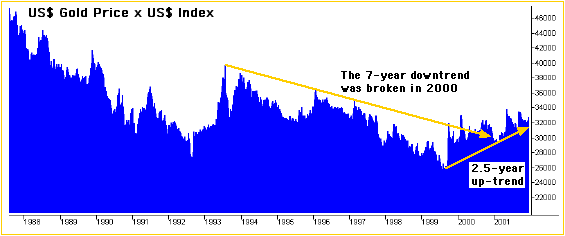
The Inflation
Mask
The following is an extract from
commentary that was posted at www.speculative-investor.com on 6th January
2002.
The US is experiencing inflation, deflation,
or something in-between, and careful observation should allow any reasonably-intelligent
analyst to clearly identify which it is (inflation, deflation, or something
in-between), right? Wrong! This is a point on which high-calibre analysts
vehemently disagree - some strongly believe that the US is experiencing
and will continue to experience inflation while others are steadfast in
their belief that the US has embarked on a deflationary spiral. Analysts
of a lower calibre, by the way, think that everything is just fine and
we shouldn't be concerned about either inflation or deflation.
We have singled -out 1997 as the year
in which the US credit bubble was born - this was about the time when the
rate of credit expansion began to accelerate and certain well-established
relationships (eg, the relationship between stocks and bonds) turned about-face.
The effects of this massive expansion of credit should have become obvious
by now in the prices of gold and the CRB Index, but they haven't (at least
not to any significant degree). The fact that they haven't is attributed
by some analysts to powerful deflationary forces, but this makes no sense
since the rate at which the money supply is expanding does not accelerate
higher (as it has done over the past few years) during a period of deflation.
There is, fortunately, a more logical explanation.
In our opinion, the source of all the
confusion is the strong Dollar. If the Dollar had been weak over the past
few years there would not be an inflation/deflation debate since the inflation
would be obvious to all.
The effects of inflation began to emerge
during the first half of 1999 - this was a period during which long-term
interest rates moved sharply higher and when both the CRB Index and the
gold price reversed upward after hitting 20-year lows. However, the effects
did not persist and the CRB Index, the gold price and long-term interest
rates dropped back to near their lows over the past 12 months. We strongly
believe that US$ strength, driven initially by a surge in the investment
demand for dollar-denominated assets (while the US economy was strong)
and later by soaring speculative demand for dollar-denominated debt securities,
is responsible for concealing the effects of inflation.
To support our view we offer the following
chart. The chart was prepared for us by Nick Laird and shows the gold price
multiplied by the US$ Index (Nick is the proprietor of http://www.cairns.net.au/~sharefin/Markets/Master.htm,
an excellent source for charts relating to the financial markets in general
and the gold market in particular). By multiplying the gold price by the
Dollar Index we end up with a result that removes the effect on the gold
price of changes in the US Dollar's foreign exchange value (it shows an
average gold price from the perspective of investors outside the US). The
chart clearly shows that the gold price, from the perspective of someone
outside the US, has been in a strong up-trend for the past 2.5 years.

Performing a similar exercise with
the CRB Index (multiplying the CRB Index by the Dollar Index) would yield
similar results. It would show that the CRB Index, from the perspective
of someone outside the US, has been in a strong up-trend since mid-1999
with last year's decline looking like a normal correction within an on-going
bull market.
If the CRB Index had been in a strong
up-trend for the past 2.5 years, rather than rallying and then retracing
all of its gains, would there be an inflation/deflation debate? We think
not, at least not as far as the present and the near future (the next 12
months) are concerned. As things currently stand, however, the debate rages
on and the inflation continues to lurk beneath the surface, ready to emerge
for the world to see as soon as the Dollar falters.
Regular financial market forecasts
and
analyses are provided at our web site:
http://www.speculative-investor.com/new/index.html
One-month free trial available.

|

